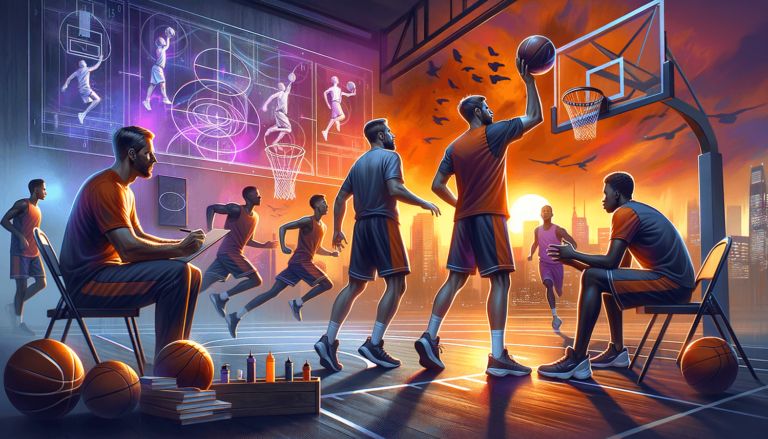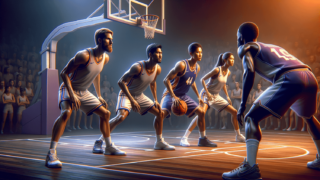
Development of Basketball-Specific Training Programs
Written by: Basketball Universe
Last updated:

Welcome to the world of Basketball-Specific Training Programs, where passion meets precision, and dedication unlocks new heights of performance! 🏀 Whether you’re a weekend warrior or a pro baller on the rise, this blog post is designed for YOU – the hoops enthusiast who wants to get the most out of their game. Say goodbye to generic workouts and hello to tailored training regimes that elevate individual skills and skyrocket team dynamics. It’s time to unlock the secrets of on-the-court success, and together, we’ll discover the tips, techniques, and tools needed to create a high-flying, laser-focused training program that’s sure to have you breaking ankles and draining buckets with the best of them. Let’s get started on your journey towards basketball greatness!
Development of Basketball-Specific Training Programs
The development of basketball-specific training programs involves designing a personalized regimen that addresses an individual player’s strengths, weaknesses, and goals. This process starts with assessing the athlete’s current skill set, physical abilities, and position requirements. Next, tailor workouts focusing on relevant attributes like agility, strength, endurance, and basketball IQ. Incorporate drills that promote skill development, including ball handling, shooting, defense, and court awareness. Finally, regularly monitor and adjust the program based on the athlete’s progress and goals to ensure continuous improvement and optimal performance on the court.
Discovering Your Basketball Identity
Before diving into the nitty-gritty of crafting your custom training program, it’s essential to identify your strengths and areas in need of improvement. Assess your current game and determine your role on your team. Are you a quick and elusive point guard or a towering and dominant center? Understanding your basketball identity is key to building a robust and personalized training program.
Self-Evaluation
Begin by conducting an honest self-evaluation of your abilities. Evaluate your footwork, shooting, passing, ball handling, court vision, and defensive capabilities. Reflect on your performance during recent games, noting which areas shone and where you struggled. Don’t forget to dive deep into basketball history and compare your style with past legends who shared your position to gain inspiration for your development.
Feedback from Coaches and Teammates
It’s crucial to gather feedback from external sources, such as coaches and teammates. They may have insights into your game that you haven’t realized or have been overlooking. Take note of their suggestions and keep them in mind as you create your basketball-specific training program.
Fundamentals to Success
No matter the position you play or your desired skill set, there are certain fundamental areas that can be universal to every aspiring baller. Keep these core principles in mind when developing your training program.
Athleticism
Basketball is a physically demanding sport that requires a strong overall fitness foundation. A well-rounded training program will include exercises that improve your strength, endurance, agility, and speed. In addition to basketball-specific exercises, consider incorporating more general exercises like plyometrics, weightlifting, and aerobic conditioning to develop your athleticism.
Shooting
The ability to score is vital at every level of basketball. Honing your shooting technique, shot selection, and offensive moves can substantially increase your impact on the court. Ensure that your training program includes a variety of shooting drills to develop different aspects, like catching and shooting, creating off the dribble, and improving shot consistency on the move.
Ball Handling
Excellent ball-handling skills are imperative for every basketball player. Building confidence with the ball in your hands allows you to make more plays for your team, whether it’s dishing out assists or penetrating the paint to score. Incorporate dribbling exercises into your routine that improve your basic dribbling abilities and increase your confidence with advanced moves.
Defense and Rebounding
An often-overlooked aspect of basketball is playing tough defense and securing the ball after a missed shot. In your training program, make sure to include defensive drills that focus on footwork, positioning, and anticipation. Add rebounding exercises, emphasizing boxing out, grabbing loose balls, and the importance of a high motor when competing for rebounds.
Designing a Basketball-Specific Training Program
With a strong foundation and understanding of the fundamentals in place, you’re now ready to design a tailored training program that addresses your unique needs and goals.
Setting Goals
Begin by establishing specific, measurable, achievable, relevant, and time-bound (SMART) goals for your training program. For example, setting a goal to improve your three-point shooting percentage by a particular margin within a certain time frame will help you stay motivated and on track.
Creating a Schedule
Determine how many days a week you can commit to training and establish a routine that accommodates your schedule. It’s essential to strike a balance between working hard and allowing your body to recover to avoid injuries or burnout. Ensure each training session has a purpose, focusing on various aspects of your game, and includes a dynamic warm-up, skill-specific drills, strength and conditioning exercises, and a cool-down with stretching.
Monitoring Progress
To measure your improvements, regularly evaluate your performance and track your progress. Set specific benchmarks and reassess your goals to keep yourself accountable. Make adjustments to your training program as necessary, based on your progress and changing needs.
Creating Drills for Different Aspects of the Game
Effective basketball-specific drills tailored to different skills are vital components of any successful training program. Here are some drill ideas for various aspects of the game:
Shooting Drills
- Spot shooting: Focus on maintaining proper form while shooting from different locations.
- Pull-up jumpers: Dribble towards your shooting spot, use a quick change of pace or direction, and then rise into your shot.
- Shooting off screens: Practice running off imaginary screens, receiving the ball, and shooting in one fluid motion.
Ball Handling Drills
- Freestyle dribbling: Dribble while moving around the court, improvising different moves and keeping your head up.
- Two-ball drills: Use two basketballs at once to improve hand-eye coordination and strengthen your weak hand.
- Defender shadowing: Have a defender mimic your movements while you dribble, forcing you to react and use different moves to create space.
Defense and Rebounding Drills
- Shuffle and slide: Improve defensive footwork by shuffling side-to-side down the length of the court while staying low.
- Closeout drills: Work on closing out to shooters, using proper hand positioning and footwork to contest the shot.
- Box-out drills: Practice boxing out an opponent in various situations, such as after a free throw or from different positions around the key.
Fueling Your Performance and Recovery
A critical aspect of your training program is proper nutrition and recovery. Ensure you are fueling your body with the right nutrients to support your growth and maintain energy levels. Hydration is crucial, so always keep water on hand during and after training sessions.
Nutrition Essentials
Eating a balanced diet that includes ample protein, complex carbohydrates, and healthy fats will ensure your body has the necessary building blocks to recover and build muscle. Focus on consuming lean proteins, nutrient-dense vegetables, whole grains, and fruits, while avoiding processed foods, refined sugars, and unhealthy fats.
Recovery Strategies
Post-training recovery is crucial for promoting muscle development and preventing injuries. Develop a post-workout routine that includes stretching, foam rolling, and low-impact activities to improve flexibility and alleviate muscle tightness.
By following these guidelines and incorporating basketball history’s knowledge and wisdom, your basketball-specific training program will set the stage for your ongoing development and success on the court.
Off-Court Elements: Developing Basketball IQ
Basketball IQ is more than just understanding the rules of the game; it’s the ability to make smart decisions on the court. As you develop your basketball-specific training program, consider incorporating various off-court resources to help elevate your basketball IQ, such as game film analysis, strategy sessions, and mentorship.
Game Film Analysis
One of the best ways to improve your understanding of the game is by watching game film, both of yourself and other teams. Analyzing your own play can help identify areas requiring improvement, as well as evaluate the effectiveness of the training program. Watching other teams, especially at higher levels, can provide valuable insights into offensive and defensive schemes, player tendencies, and various strategies that you can apply to your own game.
Strategy Sessions
Collaborate with coaches, teammates, or other basketball enthusiasts to discuss team strategies, offensive and defensive systems, and various plays or sets. These sessions can help you develop your understanding of the game and enhance your ability to read and react to different situations on the court. Additionally, consider attending coaching clinics or workshops to further your strategic insights.
Mentorship
Find experienced players, coaches, or former players who are willing to share their knowledge, experiences, and perspectives on the game. Mentors can provide valuable advice on improving your skills, adjusting your mindset, or overcoming obstacles. A strong support network can significantly impact your development as a player.
Importance of Mental Health and Mindset
Basketball is as much a mental game as a physical one. Developing a healthy, performance-focused mindset – including confidence, resilience, and poise – is crucial to achieving success on and off the court. In this section, we’ll explore different techniques and principles to help you create a strong mental foundation.
Mental Imagery and Visualization
Practicing mental imagery and visualization techniques can improve your basketball game by strengthening your mental focus, goal-setting, and performance under pressure. Visualize yourself confidently executing plays, sinking game-winning shots, and performing at your peak. Regularly incorporating these practices into your training program can reinforce positive habits and increase mental toughness.
Handling Pressure and Adversity
Competitive basketball can present high-pressure situations and challenging circumstances. It’s essential to cultivate the ability to stay calm and focused during these moments. Practice deep breathing exercises and mindfulness techniques to help steady your emotions and maintain a clear head. The more composed and resilient you become, the more likely you are to thrive under pressure.
Positive Self-Talk and Affirmations
Your inner dialogue can significantly impact your performance on the court. Engage in positive self-talk and use affirmations to help build your self-esteem, reinforce your goals, and maintain a growth mindset. Surrounding yourself with positivity and constructive self-belief can lead to greater success on and off the court.
By incorporating these additional elements into your basketball-specific training program, you’ll be well-equipped to continue making strides in your game and fully realize your potential as a player.
FAQ Section: Basketball-Specific Training Programs
Explore our FAQ section for answers to common questions about basketball-specific training programs. From getting started to maintaining motivation, we’ve got you covered with helpful insights and practical tips for your journey on the hardwood.
1. How do I begin creating my own basketball-specific training program?
Start by assessing your current skills, strengths, and weaknesses, and identify your primary goals. Armed with this self-evaluation, tailor a program that targets your specific needs and interests, incorporating exercises focusing on athleticism, shooting, ball handling, defense, and rebounding.
2. How often should I practice to see improvements?
It’s crucial to find a balance between consistent training and allowing your body time to recover. Aim to practice 3-5 times a week, ensuring each session is purposeful and targets different aspects of the game while mixing in rest days to avoid burnout and injuries.
3. How can I set realistic and achievable goals for myself?
Use the SMART (specific, measurable, achievable, relevant, and time-bound) criteria when setting goals. Determine where you want to improve, quantify the expected progress, and establish reasonable timelines while keeping your goals challenging yet achievable.
4. How can I stay motivated throughout my training program?
Track your progress, set short-term milestones, and celebrate small victories to maintain motivation. Surround yourself with a support network of coaches, teammates, and mentors who share your passion and can hold you accountable and offer encouragement.
5. What kind of drills should I focus on to improve my ball handling?
Incorporate drills that challenge your dribbling skills, such as freestyle dribbling, two-ball drills, and defender shadowing. These exercises will help enhance hand-eye coordination, improve control with both hands, and build confidence in reacting to defensive pressure.
6. How can watching game film help my performance?
Watching game film can provide valuable insights into offensive and defensive schemes, player tendencies, and various strategies. Analyzing your own play helps identify areas for improvement, while watching other teams or players can inspire new ideas and techniques for your game.
7. How important is proper nutrition for a basketball-specific training program?
Proper nutrition lays the foundation for optimal performance and recovery. A balanced diet supplies the necessary nutrients, vitamins, and minerals to support muscle growth, provide energy, and maintain overall health while training.
8. What can I do to improve my basketball IQ?
Boost your basketball IQ by analyzing game film, participating in strategy sessions, and seeking mentorship from experienced players or coaches. Educate yourself on tactical aspects, study basketball history, and engage with others in discussing in-game decision-making and strategies.
9. How can I ensure that my training program stays fresh and engaging?
Keep your training program fresh by incorporating new drills, varying workout intensities, updating your goals, and seeking feedback from coaches and teammates. Regularly reassessing and adapting your routine will keep you challenged, engaged, and progressing.
10. How can I work on the mental aspects of my game?
Enhance your mental game by practicing visualization techniques, developing a positive self-talk routine, and using mindfulness exercises to remain calm under pressure. Cultivating mental resilience and a growth mindset will positively impact your on-court performance.
Featured Posts
- No pillar pages found.





